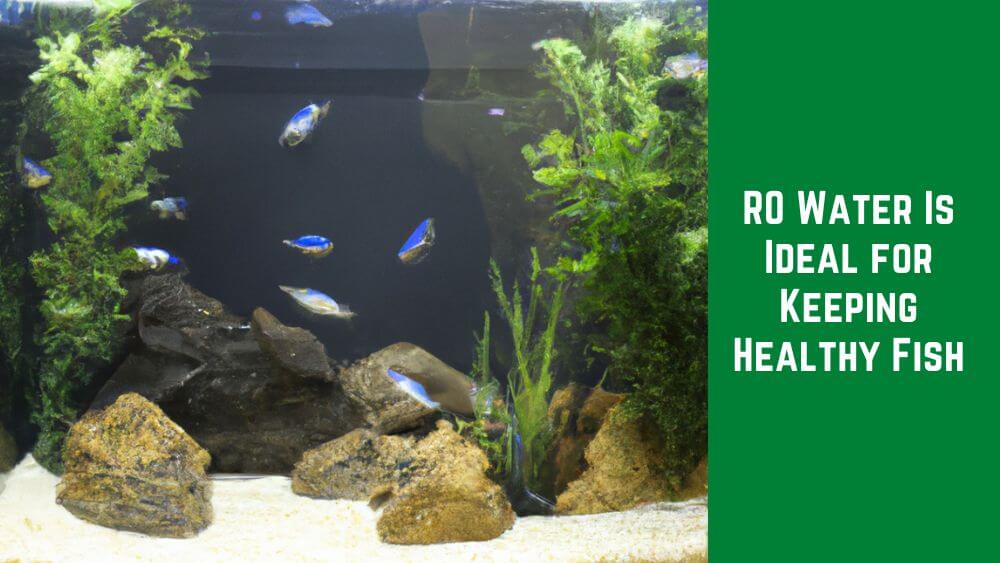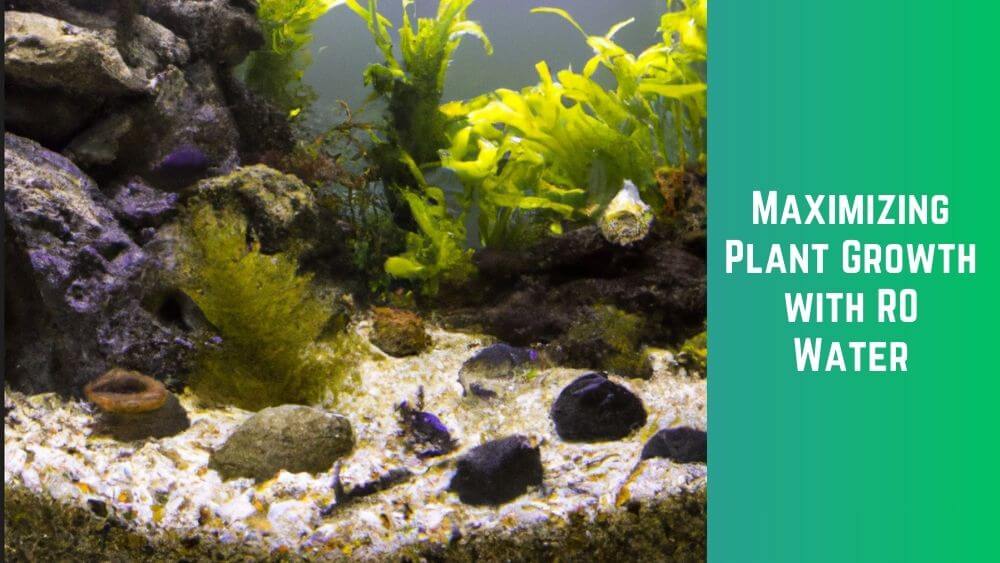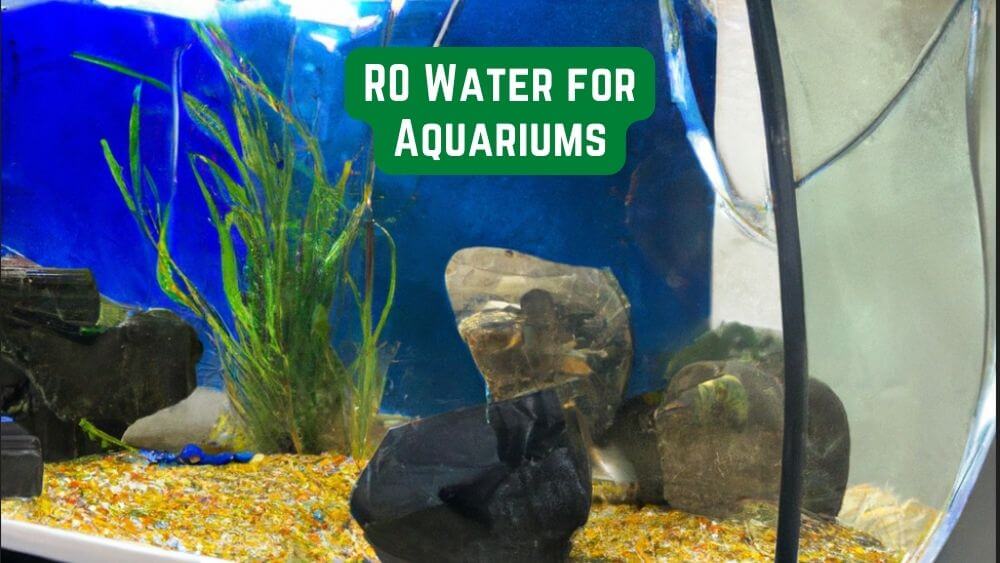Water quality is an essential factor if you want to maintain healthy and thriving aquariums. As such, many aquarists turn to reverse osmosis (RO) water to ensure their tanks receive the best possible water quality and health benefits. But is reverse osmosis water the best choice for aquariums?
In this article (by RO specialist Hasan Al Sarker), we’ll discuss the pros and cons of using RO water and answer the questions. We’ll be examining how RO water affects the water chemistry of your aquarium, as well as how it affects the health of the fish and plants. Whether you’re looking for a low-cost option for aquarium water or want to ensure your fish are getting the best water quality possible, this article will help you decide about reverse osmosis water for your aquarium.
Benefits of Reverse Osmosis Water in Aquarium
Reverse osmosis (RO) water is an excellent choice for aquariums. It is free from harmful chemicals, such as heavy metals and microorganisms, which can be present in tap water. These substances can be toxic to fish and other aquatic species, so ensuring your water is as pure as possible is important.
One of the benefits of using RO water is that it helps to keep your tank clean. Since there are no impurities in the water, it’s less likely to cause algae growth or other problems. Another benefit of RO water is that it’s great for fish health.
Pure, clean water can help to prevent diseases and infections. Plus, since there are no chemicals or pollutants in the water, it won’t harm your fish if they ingest some while swimming around. Overall, RO water is a great choice for aquariums.
It’s safe for fish and plants and can help keep your tank clean and healthy. If you’re looking for a way to improve your aquarium set-up, consider adding RO water with additional minerals to the mix!
Additionally, RO water is very consistent in its pH levels, allowing you to maintain a stable environment for your fish easily. Finally, RO water is the most affordable way to get large amounts of water for your aquarium since you can use it multiple times before replacing it.
What to Add to Ro Water for Aquarium?
Adding some key minerals when using RO water for your aquarium is important. The three most important minerals to add are calcium, magnesium, and potassium. You can find these in various products designed specifically for use with RO water.
Calcium is important for strong bones and scales in fish. It also helps maintain pH levels and prevents algae growth. Magnesium helps regulate calcium absorption and strengthens plant roots.
Potassium aids in metabolism and promotes healthy growth in both plants and fish. When adding minerals to your RO water, follow the manufacturer’s directions carefully. Overdosing can be just as harmful as not adding enough!
Are you concerned about adding minerals to the aquarium? Just add a mineral drop and stay relaxed.

How Do I Adjust my Reverse Osmosis Aquarium Water?
The reverse osmosis (RO) process is important in keeping your aquarium water clean and healthy. When adjusting the water for your aquarium, you should always do reverse osmosis first. This is because the RO process removes most of the mineral content from the water.
Once the water has been passed through the RO process, you can then adjust the water with additives, such as pH buffers and hardness buffers, to make it suitable for your aquarium. Most fish prefer soft, acidic environments or harder, more alkaline environments.
What Fish Species Prefer RO Water
Many fish prefer RO water because it is softer than tap water and easier for fish to process. Popular fish that prefer RO water include-
- Goldfish
- Guppies
- Neon tetras
- Mollies
- Platies
- Betta Fish
Can Fish Be Kept in Ro Water?
You can keep fish in RO water. Reverse osmosis (RO) water is a type of purified water that can be used in aquariums, as it contains mineral salts that benefit fish.
You have to note that RO water is extremely pure and has no buffering capabilities. So, adding the necessary minerals and buffers to the water is important before introducing fish. Additionally, we should test the water regularly to maintain the correct salt and minerals levels.
Best Practices for Maintaining RO Water in an Aquarium
One of the best ways to keep your aquarium healthy and free of toxins is to use Reverse Osmosis (RO) water for your tank. However, there are some important best practices you should follow when using RO water in your aquarium. These include:
- Testing the water pH regularly to ensure it remains stable and within the ideal range.
- Periodically testing for minerals such as calcium and magnesium and adding supplements as needed.
- Regularly change out your aquarium’s water to keep toxins at bay.
- Cleaning your RO filter regularly to ensure it is working properly.
- Adding natural supplements to your tank to help keep the water cycle balanced.
Buffering RO water in an aquarium is crucial for creating a healthy environment for fish and other aquatic life. Here’s a simplified guide:
- Start with Clean RO Water: First, ensure your RO water is clean and free from chlorine and other chemicals that can harm your fish.
- Check the pH: Test the pH of the RO water. This helps you know if it’s too acidic or too basic for your fish.
- Use a Buffer Solution: You’ll need a special solution called a buffer to adjust the pH. Choose a buffer solution that matches the pH level you want for your aquarium.
- Add the Buffer Solution: Carefully add the buffer solution to your RO water. This helps bring the pH to the right level for your fish.
- Check pH Again: After adding the buffer, check the pH again to ensure it’s where you want it to be.
- Let It Sit: Allow the water to sit for about 24 hours. This helps the buffer solution mix properly with the water.
Buffering the water ensures your aquarium has the right pH level for your fish to thrive.
Is RO Water Necessary for a Saltwater Aquarium?
For saltwater aquariums, RO water is very important. It’s like the secret sauce for a successful tank. RO water, or reverse osmosis water, is super clean because it’s been filtered to remove all the extra stuff that can make fish and corals unhappy.
In a saltwater tank, if you use regular tap water, the minerals and impurities can build up over time and cause trouble. RO water prevents this from happening.
Also, RO water helps maintain the right amount of salt in your tank. This is crucial because it lacks any extra minerals that can mess up the balance.
But remember, even though RO water is a big help, you still need to do regular water changes in your saltwater tank. That’s another key part of keeping your fish and corals healthy.
So, to sum it up, RO water is like a superhero in a saltwater aquarium. It keeps your tank clean and your fish happy, but don’t forget those water changes, too!

Is Ro Water Good for a Planted Aquarium?
Keep some things in mind before using RO water in your planted aquarium. First, RO water contains no minerals or nutrients that plants need to grow. This means you’ll need to add a mineral drop to your tank if you want your plants to thrive.
If you use RO water in your planted aquarium, monitor the pH levels carefully and adjust as needed. Using RO water in your planted aquarium can be challenging. Make sure you take the necessary precautions and research what plants will do well in RO water.
Can I Mix Ro Water With Tap Water for Aquarium?
When filling up a new aquarium, we often ask whether it is okay to mix RO water with tap water. The short answer is yes. You can mix RO water with tap water for your aquarium. Many aquarists do this regularly without any problems.
When mixing RO water with tap water for your aquarium, there are a few things to keep in mind. First, it’s important to understand that RO (reverse osmosis) water is very pure and doesn’t contain any dissolved minerals or other impurities found in tap water. This means mixing RO water with tap water can result in higher levels of dissolved minerals and contaminants in your aquarium than if you had just used tap water alone.
While this isn’t necessarily bad, it is something to be aware of. If you have sensitive fish or plants in your aquarium, they may not do well in waters with high dissolved minerals and impurities. In general, however, most fish and plants will be fine if you mix RO water with tap water for your aquarium.
In summary, yes – you can mix RO Water with Tap Water for your Aquarium without any problems! Just remember that doing so may slightly increase dissolved minerals and impurities present – but this shouldn’t pose any serious threat to most fish or plants!
Can I use Distilled Water in a Saltwater Aquarium?
Using distilled water in a saltwater aquarium is not recommended, as the water has been processed and may contain very few minerals and other beneficial compounds. Distilled water also has a very low pH, which can lead to an imbalance within the aquarium.
Additionally, distilled water does not contain the trace elements necessary for the healthy growth of marine life. It is best to use reverse osmosis (RO) water or purified water for saltwater aquariums, as these are not overly processed and have been specifically designed for this purpose. For the health of aquatic life, it is best to use water that has been tested for quality and is safe for marine use.
Does the Goldfish Tank Need to Use RO Water?
RO water has a neutral pH, which means it’s not too acidic or too basic, which is good for your goldfish. It helps create a stable environment in the tank, and that’s what your goldfish like. But here’s the thing, RO water doesn’t have some important minerals that your goldfish need. So, you should add those minerals back into the water. You can do this by using mineral drops. This way, you keep your goldfish happy and healthy, and RO water helps. So, using RO water in your goldfish tank is a smart choice for your fishy friends!
How Long Can You Store Ro Water for Aquarium?
It is ideal for storing RO water in an aquarium for 15 to 30 days. But, it depends on a few factors. First, if you’re storing RO water for future use, it’s important to keep it in a clean, dark container. Light and impurities can cause the water to degrade over time.
Second, the storage area’s temperature will also affect your RO water’s shelf life. Warmer temperatures will cause the water to degrade more quickly than cooler temperatures. Ideally, storing RO water within two weeks of holding it would be best.
However, if you must store it for longer periods, it’s still possible to use stored RO water successfully if you take proper precautions and follow these storage guidelines.
Ro Water for Tropical Fish
One of the most important things to consider when setting up a tropical fish tank is the type of water you will use. While many people opt for distilled or RO water, there are some benefits to using RO water for tropical fish.
This process leaves behind pure H2O, which is ideal for tropical fish tanks. One benefit of using RO water is that it contains no dissolved minerals, which can build up in your tank over time and cause problems for your fish. Another benefit of using RO water is its very stable pH level.
This is important because much tropical fish are sensitive to changes in pH levels and can become sick or even die if the levels fluctuate too much. Using RO water, you can be sure that your pH levels will remain constant, giving your fish a much healthier environment. If you’re considering setting up a tropical fish tank, consider using RO water.
It’s purer than other types of water and will help keep your fish healthy and happy!
Significance of PH-level in Water for Aquarium
The pH level of water is extremely important in a fish aquarium as it affects various biochemical processes. A low pH can be toxic to aquarium fish, leading to health problems and even death, and maintaining a neutral pH level of around seven is ideal for most aquarium fish.
You can add buffers or specialized aquarium additives to raise or lower the pH. Higher pH levels can cause rapid gill damage and disrupt the fish’s ability to absorb essential nutrients, making them more prone to disease. Additionally, a low pH can cause slow growth and death due to the accumulation of toxic metals. Maintaining the proper pH levels is vital in ensuring the health and well-being of aquarium fish.
Final Words
Finally, RO water is an excellent option for aquariums and can provide quality water for your fish and other aquatic life. It can be used for fresh and saltwater aquariums and is relatively easy to install and maintain. Although it is more expensive than other water sources, it is an excellent choice for those who want to provide their fish with the best quality water possible.

Hasan Al Sarker is a Reverse Osmosis Specialist. He has worked for many years to ensure safe drinking water for all. His research paper has been published in several journals, including Issue, Medium, and Slideshare. He is recognized as a water doctor among specialists though he did not attend medical college.
Besides working as a researcher of reverse osmosis technology, he is also very fancy with the kitchen and cooking. His guides are reading thousands of people every day. As a head of content, he is responsible for all the published articles at RO System Reviews.

